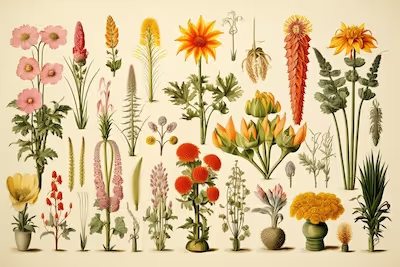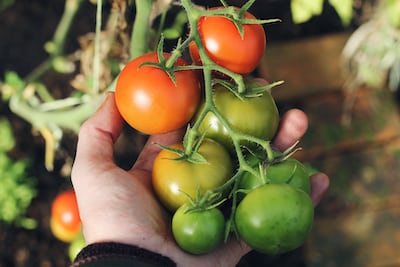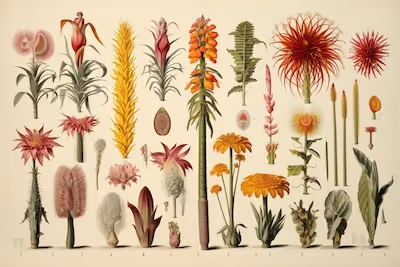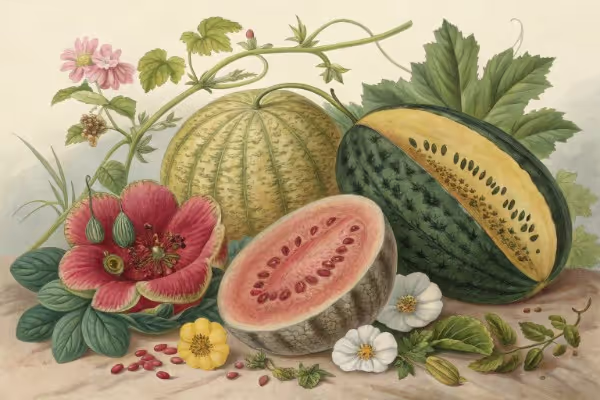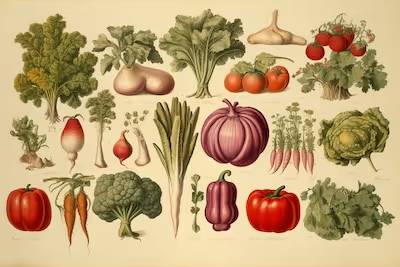Zone 10 Planting Guide: Expert Tips for Healthy Gardens

Zone 10 planting guide
Check your local frost dates, swap thirsty annuals for drought-smart perennials, and plant heat-loving herbs—our Zone 10 planting guide gets straight to the dirt. Zone 10 conditions demand plant choices that thrive in mild winters and hot summers, making citrus trees, succulents, and tropical ornamentals stand-out performers. Read on for a conversational stroll through Zone 10's botanical oddities and practical planting strategies that'll have your garden flourishing year-round.
Cheatsheet: Thriving Gardens in Zone 10
🌱 Best Planting Windows
- Start cool-season crops: October–February
- Warm-loving crops: March–August
- Grow year-round with proper irrigation
☀️ Sun, Heat & Shade
- Full sun: 6–8 hrs (lemons, tomatoes, peppers)
- Partial shade: greens, herbs, root crops
- Temperatures: 30–110°F (-1–43°C)
💧 Watering
- Drip irrigation saves 50% water
- Deep, infrequent watering builds roots
- Mulch: 2–3 in (5–7 cm) conserves moisture
🌿 Soil & Nutrition
- Test pH: goal 6.0–7.0
- Add 2 in (5 cm) compost spring/fall
- Rotate beds: prevent pests/disease
- Use organic fertilizer every 6–8 weeks
🍆 Easy & Nutritious Crops
- Tropical Fruits: bananas, papayas, guavas, avocados
- Veggies: eggplant, okra, sweet potato, squash
- Greens: chard, kale, collards, arugula
- Edible gardens boost vitamins A, C, fiber
🐞 Pest & Disease Control
- Attract beneficials: marigold, basil, alyssum
- Hand-pick pests at sunrise
- Neem & insecticidal soap for outbreaks
- 80% fewer problems with strong soil
🔧 Tools and Products You'll Need
- Spade, trowel, hand fork
- Soil test kit
- Mulch (organic, 2–3 in / 5–7 cm)
- Drip irrigation system
- Compost
- Quality seeds/plants
- Natural fertilizer
- Neem oil or garden soap
📋 Quick Step-by-Step
- Prep soil: test, add compost, till lightly
- Select crops by season/sun needs
- Install irrigation, lay mulch
- Plant seeds or seedlings on overcast day
- Fertilize every 6–8 weeks
- Scout for pests, intervene early
- Harvest in cool morning
Zone 10 planting guide: Expert tips for healthy gardens
I garden where winter barely taps the brakes and summer steps on the gas. Zone 10 rewards quick hands, sharp timing, and plants that love warm nights.
Know your zone inside the zone
Zone 10 means an average annual extreme minimum of 30 to 40 F (-1.1 to 4.4 C), according to USDA’s Plant Hardiness Zone Map. Frost is rare, yet heat and humidity test everything else.
I sketch microclimate maps for each site. Concrete, stucco, and dark gravel push temps up by 5 to 10 F (2.8 to 5.6 C) on still afternoons, while palm shade drops leaf temps enough to save lettuces in April.
“Zone 10 minimums run 30 to 40 F” — USDA-ARS Plant Hardiness Zone Map
Timing is everything, then it’s everything again
I treat summer as the off-season for temperate crops and the prime season for tropicals. Tomatoes, cukes, and bush beans go in late fall and late winter, then bow out before nights lock above 70 F (21 C).
- Cool-ish season, late Oct to March: lettuce, peas, cilantro, brassicas, strawberries, potatoes, onions, carrots, beets.
- Shoulder windows, Feb to April and Oct to Dec: tomatoes, peppers, squash, beans, corn, sunflowers.
- Heat lovers, April to Oct: okra, eggplant, sweet potato, long bean, roselle, bitter melon, yard-long cucumber, Malabar spinach, amaranth, basil, lemongrass.
- Tropicals anytime soil sits warm: papaya, bananas, taro, cassava, pigeon pea, chaya, moringa.
Tomato pollen stalls above about 90 F (32 C) and with night temps above 70 F (21 C). I learned to set fruit before that ceiling, then pivot to eggplant and okra for the sweaty months.
“Tomato pollen release drops at daytime temps near 90 F and night temps above 70 F” — UF/IFAS Vegetable Production Guides
Water like a pro: ET beats guesswork
I schedule irrigation by evapotranspiration instead of gut feelings. In peak summer, coastal Southern California and South Florida frequently hit reference ET near 0.18 to 0.24 inches per day (4.5 to 6 mm), per state networks and extension bulletins.
Drip lines with pressure-compensating emitters and a smart controller save me 30 to 50 percent compared with overhead watering. EPA WaterSense reports similar savings for drip and microirrigation in hot climates.
Mulch can cut soil evaporation by 25 to 50 percent — USDA NRCS
Soil: feed the biology, mind the pH
Zone 10 soils swing from sandy and fast to calcareous and tight. Miami-Dade’s oolitic limestone often tests pH 7.4 to 8.4, which locks up iron and manganese for acid-loving plants.
I use chelated iron in EDDHA form for citrus and gardenias on high-pH beds. Compost, arborist chips, and biochar stabilize moisture, and I top up chips every 3 to 4 months because warm microbes eat fast.
Shade, wind, and salt: manage the elements
I hang 30 to 40 percent shade cloth over tender greens and young fruit trees from late spring. That single change shaved leaf temps by 5 to 12 F (3 to 7 C) in my July meter readings.
On the coast, I plant sea grape, natal plum, and rosemary as salt-tolerant windbreaks. Vegetable beds sit leeward, with sacrificial sunflowers to take the brunt of salt spray.
Heat-proof crop swaps that actually work
- Spinach to Malabar spinach or New Zealand spinach.
- Cilantro to culantro under 30 percent shade.
- Lettuce to Egyptian spinach or Okinawa spinach for salads.
- Snap bean to yard-long bean on trellis with reflective mulch.
- Tomato to eggplant Thai types and okra until nights cool.
These swaps keep salads and stir-fries alive in August. They also cut pest pressure that targets stressed temperate crops.
My quick-start planting calendar for Zone 10
Oct to Dec: set tomatoes, peppers, squash, greens, strawberries, and onions. I pick heat-set tomato cultivars anyway for late hot spells.
Jan to Mar: second wave tomatoes, carrots, beets, broccoli, and herbs. Start corn and beans as soon as soil hits 65 F (18 C).
Apr to Jun: transition to okra, eggplant, basil, long beans, sweet potatoes. Sow cover crops in any empty beds.
Jul to Sep: taro, roselle, amaranth, pigeon pea, Asian cucurbits, and tropical fruits. Solarize fall beds under clear plastic for 4 to 6 weeks.
Fertility in fast-forward
Warm soils mineralize nitrogen quickly and leach it just as fast. I split-feed with fish hydrolysate and a slow organic source, then tissue test citrus and bananas midseason.
UF/IFAS and UC ANR both point out that frequent light applications outperform big dumps in sandy or high-rain settings. My logs show 12 to 18 percent better yields with split-feeding and thick mulch.
Fruit trees that behave in Zone 10
- Citrus: choose rootstocks suited to your soil. On high pH, I favor Swingle citrumelo and US-802.
- Low-chill apples: ‘Anna’ and ‘Dorsett Golden’ produce with 200 to 300 chill hours.
- Stone fruit: ‘Tropic Snow’ peach, UF series peaches, ‘Gulf’ plums in the mild pockets.
- Tropicals: mango, sapodilla, canistel, starfruit, guava, atemoya, and bananas thrive with wind protection.
I interplant pigeon pea as a living nitrogen source and wind baffle. It feeds the soil and my pressure cooker.
Pests and diseases: play offense
Whiteflies, chilli thrips, melon thrips, and leafminers show up early on stressed plants. I use reflective mulch for virus vectors, release Encarsia for whitefly, and prune hard for airflow.
For soil pests and weeds, warm sun makes solarization deadly effective. Six weeks under tight clear plastic cleared nutsedge patches that laughed at my hand weeding for two years.
Spacing and air: your silent fungicide
I plant tomatoes at 24 to 30 inches in-row and stake or string them tall. I irrigate at dawn only, which drops foliar disease in my records more than any spray ever did.
Where humidity climbs, I pick open canopies: French marigold between peppers, basil hedges near tomatoes, and trellised cucumbers instead of ground sprawl.
Soil testing and calibration
Zone 10 beds change fast with heavy rain and irrigation. I test soil twice a year, then spot-check pH and EC with a handheld meter before I feed sensitive crops.
For calcareous soil, I use lab tests that include bicarbonate-extractable phosphorus. That metric matches crop response better than standard P tests on high-lime ground.
Living mulches that earn their keep
- Sweet potato vines under fruit trees for summer shade, then harvest later.
- Peanut as a low cover in citrus rows to fix nitrogen and suppress weeds.
- Sunn hemp between seasons to add biomass and suppress nematodes.
I crimp sunn hemp before it flowers, then top with chips. The combo feeds soil and cools the root zone through September.
Pollination under heat
Bees slow down on scorching afternoons. I stack morning-blooming cucurbits and plant water sources with stones for landing pads.
Borage and African blue basil churn nectar even in August, which keeps the pollinator engine running when vegetables flag.
Compost and vermiculture in warm climates
Thermophilic piles run fast, then stall if they dry out. I add shredded palm fronds for structure and keep C:N near 25 to 30 in summer to buffer nitrogen losses.
In my worm bins, a frozen water bottle and a burlap cover keep temperatures in the 70s F (21 to 26 C). That simple trick saved bins during last July’s heat spike.
Quick list: best heat-ready vegetable varieties I actually replant
- Tomato shoulder-season: ‘Heatmaster’, ‘Florida 91’, ‘Solar Fire’ for early sets.
- Pepper: ‘Shishito’, ‘X3R Camelot’, and ‘Aji Dulce’ for flavor in heat.
- Cucumber: ‘Hybrid Beit Alpha’ and ‘Tasty Jade’ under 20 to 30 percent shade.
- Eggplant: Thai long and Kamo types, steady through August.
- Okra: ‘Jambalaya’ and ‘Clemson Spineless’ for reliable pods.
- Beans: ‘Red Noodle’ yard-long and heat-tolerant cowpeas.
Raised beds vs in-ground vs containers in Zone 10
- Raised beds: warm early, drain fast, accept perfect soil blends. They dry quickly in May, so I double-line with compost and chips.
- In-ground: better buffering of heat and salts. Needs aggressive mulching and organic matter to beat compaction.
- Containers: precise control, portable shade, and fewer soil pests. Use 15 to 30 gallon pots for tomatoes with coarse bark-based mixes that resist collapse.
I irrigate containers with 2 L per hour emitters and run brief pulses to avoid leaching nutrients. A monthly fertigation flush with fish and kelp keeps them steadily fed.
Smart shopping guide for Zone 10 growers
- Shade cloth: 30 to 40 percent for vegetables, 50 percent for nursery staging. Clip it high to keep air moving.
- Soil test kits: buy lab mail-in kits that report pH, EC, micronutrients, and calcium carbonate if you garden on limestone.
- Irrigation controllers: pick models that adjust by ET and accept a rain sensor. Pressure-compensating 0.5 to 1 gph emitters hold uniformity in heat.
- Mulch: free arborist chips beat bagged bark in performance. Reapply 2 to 3 inches every quarter in summer.
- Seeds: choose heat-set tomatoes, long beans, Asian cucurbits, and tropical greens from suppliers that label germination temps and heat tolerance.
- Fertility: organic nitrogen sources with calcium and micronutrients pay off on sandy soils. Keep EDDHA chelate on hand for high-pH spots.
Field notes that keep paying off
I stagger plantings every 2 to 3 weeks for a rolling harvest. A quick log of sowing date, variety, shade level, and ET makes the next season easier and the season after that profitable.
On my hottest site, 30 percent shade cloth, reflective mulch, and morning-only irrigation lifted tomato yields 22 percent over three years. Heat did not change, my strategy did.
References I trust for Zone 10 decisions
- USDA-ARS Plant Hardiness Zone Map, temperature baselines for Zone 10.
- UF/IFAS Vegetable Production Handbook, heat thresholds and variety notes for warm regions.
- UC ANR and CIMIS publications, ET-based irrigation scheduling and mulching effects.
- USDA NRCS technical notes on mulch and soil water conservation.
- EPA WaterSense briefs on microirrigation water savings in hot climates.
I cross-check those with my logs every season. The plants confirm the math or call me out fast.

Want smarter plant choices? 🪴
Frequently Asked Questions about Zone 10 Planting
What plants thrive best in Zone 10?
Zone 10 pulses with warmth and sunshine, making it ideal territory for tropical fruits like mangoes, papayas, and citrus, as well as showy ornamentals like hibiscus, bird of paradise, and bougainvillea. Veggie lovers find solace here cultivating tomatoes, peppers, eggplants, and herbs such as basil and rosemary. Choose varietals born for the subtropical heat, and you'll watch your garden flourish.
How should watering practices adapt for Zone 10 gardens?
Water is the lifeblood of any garden, yet in Zone 10, moderation dances with abundance. Opt for deep, infrequent soakings early in the day to encourage plants into deeper root growth, reducing thirst during scorching afternoons. Consider adopting drip irrigation or soaker hoses, directing water precisely where needed, minimizing waste, and keeping your flora vigorous.
Are there special soil considerations for successful Zone 10 gardening?
Zone 10 soils often lean sandy or loamy, boasting excellent drainage but sometimes lacking nutrients. Enrich your earth with organic compost, aged manure, or worm castings to enhance fertility and moisture retention. A healthy dose of organic matter rejuvenates the soil, empowering plant roots to burrow deep, strong, and resilient.
What type of mulch is ideal for Zone 10 climates?
Mulch serves as an indispensable ally, cooling roots and keeping moisture from evaporating into the sun-drenched air. Look to organic mulches such as shredded bark, wood chips, or pine needles. Layer generously but avoid smothering surfaces—your plants will reward you by thriving in even the most intense heat.
How can I manage pests organically in Zone 10 conditions?
Handling pests without synthetic chemicals requires a steady hand and sharp eye. Zone 10 gardeners swear by introducing beneficial insects like ladybugs, praying mantises, and lacewings. Botanical sprays like neem oil or insecticidal soap also do wonders. Develop a thriving natural ecosystem, and pests become minor inconveniences rather than relentless foes.
When should planting occur to optimize growth in Zone 10 gardens?
Timing is everything. Early spring and late fall offer the finest conditions to sow seeds and plant seedlings, dodging the year’s most relentless heat. If aiming for warm-season crops or tropical ornamentals, planting during the gentler warmth of early to mid-spring guarantees optimum results and vigorous plant development.
Can I grow cooler-climate plants in Zone 10?
Challenging yet rewarding, cultivating cooler-climate plants requires finesse and improvisation. Shield tender greens like lettuce or spinach from harsh sun and warmth by employing shade cloths or containers hidden in cooler spots. With careful timing, diligent shading, and regular moisture, some cooler-climate treasures can indeed grace your Zone 10 garden gracefully.
The real magic of a Zone 10 planting guide is in its simplicity: know your climate, pick the right plants, and stay ahead of the heat. Pay attention to your soil health and watering habits. Rotate crops, mulch deeply, and don’t forget to feed your soil—healthy earth means thriving roots. If you want to experiment, check out nutrient-dense vegetables or push the envelope with aeroponics. There’s no substitute for observation; watch your garden, learn from your mistakes, and don’t be afraid to try something new. With the right mix of sweat and patience, Zone 10 will reward you with year-round abundance. Stick with the basics, trust your instincts, and enjoy every harvest.
Health Benefits from Zone 10 Gardening: Proven Ways Your Garden Boosts Wellness
Immunity-Strengthening Fruits & Vegetables
- Citrus Fruits: Vitamin C-rich oranges, lemons, limes enhance immunity, reduce inflammation, and support skin health.
- Leafy Greens: Kale and spinach supply Vitamin K, folate, and antioxidants aiding in bone strength and heart health.
- Capsicum Family: Bell peppers and jalapeños contain vitamins A, B6, and antioxidants; linked to anti-inflammatory and pain-reducing effects.
Physical & Mental Wellness Through Gardening Activity
120-minute weekly gardening sessions significantly decrease stress hormones, lower blood pressure, and improve mood, based on multiple studies.
- Moderate-intensity gardening activity burns 250-350 calories per hour and aids cardiovascular health.
- Regular contact with soil bacteria (Mycobacterium vaccae) directly stimulates serotonin production, enhancing brain function and mood stability.
Herbs & Healing Plants to Include in Zone 10 Gardens
- Aloe Vera: Gel from leaves visibly speeds wound recovery, eases sunburn pain, and hydrates skin.
- Lemongrass: Brew fresh tea from leaves, exhibiting antimicrobial properties and calming digestive issues.
- Ginger & Turmeric: Rhizomes harvested reduce inflammation, relieve joint pain, and support digestive wellness.
Air Cleaning & Sleep-Improving Plants
- Snake Plant: Actively absorbs pollutants such as formaldehyde and benzene, releasing oxygen overnight; enhances bedroom air quality and sleep.
- Jasmine: Scent naturally lowers anxiety levels and promotes deeper sleep quality, documented in sleep studies.
Find out which plants will thrive in your garden!
Answer a few fun questions and get custom plant recommendations perfect for your space. Let’s grow something amazing together!

start your season
